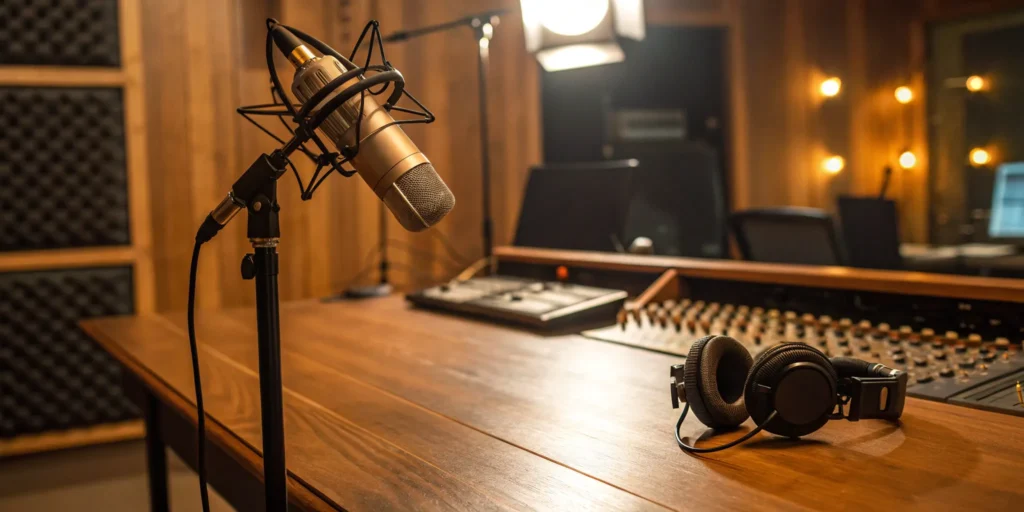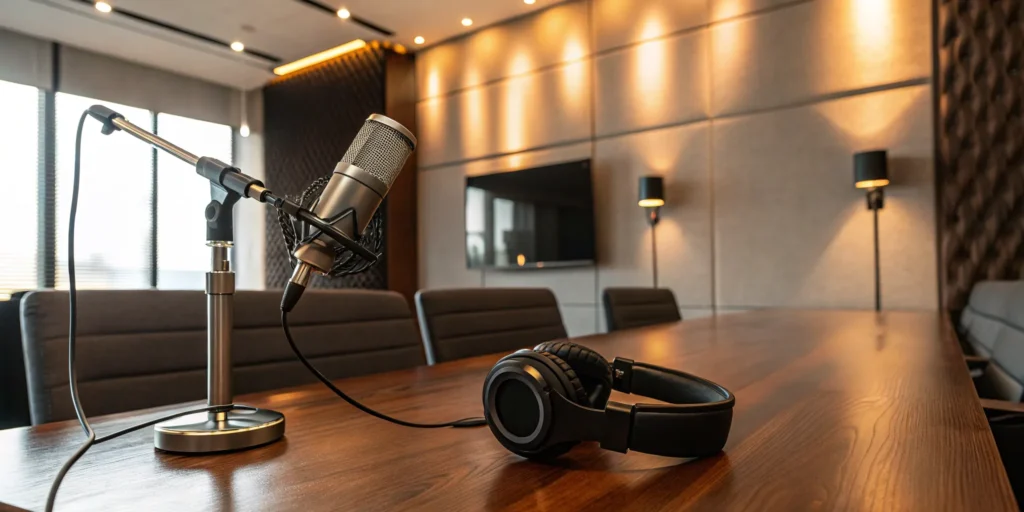You have the expertise. You’ve built a brand, written a book, or led a company. Now, you’re looking for a way to share your insights on a deeper, more personal level. A podcast offers a direct line to an engaged audience, allowing you to build authority and connect with people in your own voice. But the path from concept to launch can seem complex. This guide is designed to simplify that process. We’ll walk you through every essential step, from choosing the right microphone to developing a content strategy that resonates. We’ll cover the practical, actionable details of how to publish a podcast, ensuring your message reaches the audience it deserves.
Key Takeaways
- Establish Your Strategy First: Your podcast needs a clear purpose to succeed. Define your specific niche, plan your initial batch of episodes, and set a realistic publishing schedule to create a focused show that respects both your time and your listeners’.
- Prioritize High-Quality Audio: Your podcast’s sound is a direct reflection of your professional brand. Invest in a good microphone and record in a quiet space to ensure your expertise comes through clearly, building subconscious trust with every listener.
- Package and Promote Your Show for Success: A polished launch sets the stage for growth. Secure a reliable hosting platform, create professional cover art that aligns with your brand, and submit your show to key directories like Apple Podcasts and Spotify to make it discoverable.
Why Start a Podcast?
If you have a story to tell, expertise to share, or a brand to build, a podcast offers a direct and personal line to an audience that is actively seeking valuable content. It’s more than just hitting “record”; it’s about creating a space where you can connect with people on a deeper level, sharing your passion and insights in your own voice. This medium provides a unique platform for creative expression and allows you to build a genuine community around your message.
Think of a podcast as a way to build relationships at scale. It allows you to share your stories and expertise, establishing yourself as a go-to authority in your field. For authors, CEOs, and founders, this is an incredible tool for humanizing your brand and building trust. Listeners feel like they know you, which is a powerful foundation for any professional relationship. The demand for authentic audio content is strong, giving you a direct path to an engaged audience.
The potential reach is enormous. With millions of people tuning into platforms like Spotify and Apple Podcasts daily, you can tap into a global audience eager for new content. But a podcast is also a smart strategic move for your business. It can become the engine for your entire content strategy, helping you enhance customer engagement and drive qualified traffic back to your website, book sales page, or other platforms. By consistently providing value, you’re not just creating episodes—you’re building a powerful asset that supports your long-term goals.
Get the Right Equipment and Software
While you don’t need a state-of-the-art recording studio, the right equipment is essential for producing a podcast that sounds professional. For leaders, authors, and public figures, audio quality is a direct reflection of your brand. Think of it this way: you wouldn’t publish a book filled with typos or show up to a keynote in a wrinkled suit. Your podcast’s sound is the audio equivalent. A clear, crisp sound tells your audience that you value quality and are serious about your message. It builds subconscious trust and authority before you’ve even said your first word. Conversely, crackly, distant, or echoey audio can distract from your expertise and make you sound amateurish, undermining the very credibility you’ve worked so hard to build. Getting this right from the start will save you countless hours in post-production and help you command respect with every episode.
Luckily, a great setup is more accessible than ever. You only need three core components to get started: a quality microphone to capture your voice, a good pair of headphones to monitor your sound as you record, and intuitive software to record and edit your audio. Investing wisely in these three areas will provide the foundation for a polished podcast that allows your insights to shine. We’ll walk through exactly what to look for in each piece of gear so you can make the right choices for your specific needs and budget.
Choose Your Microphone and Audio Interface
Your microphone is the single most important piece of equipment you’ll buy, as it’s responsible for capturing your voice. Investing in a good quality microphone is crucial for achieving clear audio. The two main types you’ll encounter are USB and XLR. USB microphones are incredibly user-friendly for beginners; you simply plug them directly into your computer and start recording. They are a fantastic, straightforward option.
For those seeking higher, broadcast-quality sound, XLR microphones are the professional standard. They offer richer audio but require a separate device called an audio interface to connect to your computer. This small box acts as a bridge, converting the mic’s signal and giving you more control over recording levels. For CEOs and authors who want to ensure their podcast meets the highest standards, an XLR setup is a worthwhile long-term investment.
Select Headphones for Monitoring
Recording without headphones is a common mistake that can ruin an otherwise great take. You need to hear exactly what your microphone is picking up in real-time, from your voice levels to any distracting background noise. Using closed-back headphones is recommended for monitoring your audio while recording. This style creates a seal around your ears, which is important for two reasons.
First, it isolates the sound, allowing you to hear your audio clearly without distractions from your environment. Second, it prevents the audio from your headphones from “leaking” out and being picked up by your sensitive microphone, which can create an echo or feedback loop. Monitoring your recording live helps you adjust your performance on the fly—like moving back from the mic if you’re too loud—and saves you significant time during the editing process.
Pick Your Recording and Editing Software
Once you have your hardware, you need software to capture and refine your audio. This is where you’ll record your episodes, cut out mistakes, add intro music, and polish the final track. Popular recording and editing software options include Audacity, which is free and user-friendly, making it a perfect starting point for anyone new to audio production. It has all the essential features you need to create a great-sounding show.
For those who want more advanced tools, Adobe Audition offers a professional-grade suite of features for mixing, mastering, and audio restoration. Another excellent tool to consider is Descript, which has revolutionized editing with its intuitive, transcript-based workflow. It allows you to edit your audio file by simply editing the text, which is a game-changer for busy professionals who are more comfortable working with documents than complex audio timelines.
Plan Your Podcast
Before you even think about hitting record, you need a solid plan. A great podcast doesn’t just happen; it’s built on a strategic foundation that aligns with your brand and speaks directly to the people you want to reach. As an expert in your field, you already have the knowledge. This planning stage is about structuring that knowledge into a compelling and consistent show that establishes your authority and grows your influence. Taking the time to map out your podcast now will save you countless hours and headaches later, ensuring every episode you produce has a clear purpose.
Define Your Niche and Audience
The most successful podcasts are built on a specific, well-defined niche. It’s tempting to create a broad show to attract everyone, but that approach usually attracts no one. Instead, get specific. What is the one core topic you are deeply passionate about and can talk about endlessly? Your expertise as a founder, author, or CEO is your starting point. From there, narrow it down to a specific angle that serves a particular audience. Think about who you want to listen to. What are their challenges? What solutions can you offer? A focused niche helps you create targeted content that resonates, making it easier to build a loyal audience that sees you as a go-to resource in your space.
Create a Content Strategy and Format
Once you know your niche, it’s time to plan your content. Winging it is one of the most common mistakes new podcasters make and it leads to disorganized, uninspired episodes. Your content strategy should outline your first 8-10 episode topics, potential guests, and key talking points. Also, decide on a format. Will you host solo episodes, conduct interviews with other experts, or lead a panel discussion? Each format has its own workflow. To make your content more engaging, plan to ask specific, thought-provoking questions that encourage listeners to think. A clear content strategy ensures you always have a bank of ideas ready to go, keeping your show focused and valuable.
Develop a Consistent Publishing Schedule
Consistency is currency in the podcasting world. Your audience will come to expect new episodes on a regular basis, whether that’s daily, weekly, or bi-weekly. An inconsistent schedule is a quick way to lose listeners who move on to more reliable shows. Decide on a realistic publishing frequency you can stick to for the long haul. Many beginners underestimate the commitment required to produce a podcast, from recording and editing to writing show notes and creating promotional assets. It’s better to publish one high-quality episode every two weeks than to release three episodes one week and then go silent for a month. Choose your schedule, announce it to your audience, and honor it to build trust and anticipation.
Record and Edit Your Episodes
Once your strategy is in place, it’s time to hit record. The quality of your audio is a direct reflection of your brand, so this isn’t a step you want to rush. Listeners are quick to abandon a podcast that sounds unprofessional or is difficult to hear. A clean, crisp recording tells your audience that you value quality and are serious about the message you’re sharing. Think of it as the audio equivalent of a well-tailored suit—it immediately establishes credibility.
The good news is you don’t need a professional recording studio to produce high-quality sound. With a bit of planning and the right techniques, you can create a polished podcast from your home or office. The key is to focus on creating a great recording environment first, then capturing the best possible audio, and finally, cleaning it all up in the editing process. This three-step approach ensures your final product sounds professional and keeps your listeners engaged from the first word to the last.
Set Up Your Recording Space
Your recording environment has a massive impact on your audio quality. You want to find a space with minimal background noise—think humming refrigerators, air conditioners, or street traffic. A smaller room with soft surfaces is ideal, as it helps absorb sound and prevent echo. A walk-in closet is a classic choice for a reason!
To improve your sound, you can use simple soundproofing materials like blankets, pillows, or rugs to dampen any reverb. Hang a heavy blanket on the wall behind your microphone or record under a duvet for a quick and effective solution. The goal is to create a “dead” space where your voice is the only thing the microphone picks up clearly.
How to Record High-Quality Audio
Investing in a good microphone is one of the best decisions you can make for your podcast. Your computer’s built-in mic just won’t cut it. For beginners, a USB microphone is a fantastic, user-friendly option that plugs directly into your computer. If you’re ready for a more professional setup, an XLR microphone will deliver superior quality, though it requires an audio interface to connect to your computer.
When you’re ready to record, use software like Audacity (free) or GarageBand (free on Apple devices) to capture your audio. Before you start your main recording, do a quick soundcheck to ensure your levels are right—you don’t want the audio to be too quiet or so loud that it distorts. Following a few basic podcast recording techniques will make your editing process much smoother.
Edit for a Polished Final Cut
Editing is where you transform your raw recording into a professional, seamless listening experience. This is your chance to remove mistakes, long pauses, and distracting background noises that you couldn’t eliminate during recording. The goal is to create a smooth flow that keeps your listener hooked.
Using your recording software or a dedicated program like Adobe Audition, you can trim unwanted sections, balance the audio levels, and add your intro music and any other sound effects. This is also where you can use tools like noise reduction to clean up any lingering hiss and equalization to enhance the clarity of your voice. A solid editing process is the final step in ensuring your podcast meets the high standards of your personal brand.
Choose a Podcast Hosting Platform
Once your episode is recorded and edited, you need a place for it to live online. This is where a podcast hosting platform comes in. Think of it as a specialized storage service for your audio files. You can’t just upload an MP3 to your own website because the files are large and would slow your site down. A dedicated host is built to store and deliver these large files efficiently to your listeners, no matter where they’re tuning in from.
Your hosting platform will generate the RSS feed, which is what you’ll submit to directories like Apple Podcasts and Spotify. This feed automatically sends your new episodes and show details out to the world. Choosing the right host is a foundational step that makes the entire distribution process smoother. A good platform provides reliable storage, generates your RSS feed correctly, and offers analytics to help you understand your audience. It’s the technical backbone of your show, so picking a solid one from the start saves you a lot of headaches down the line.
7. Engage with Media on Social
Social media has become an indispensable tool for modern PR. Platforms like X (formerly Twitter) and LinkedIn are where many journalists discover stories, find sources, and interact with their community. Following and thoughtfully engaging with reporters in your field is a great way to get on their radar. Share their articles, offer insightful comments, and position yourself as a helpful resource. This approach allows you to build relationships with journalists in a more organic way than a cold pitch. When you do eventually reach out with a story idea, they’ll already be familiar with you and your expertise.
What to Look for in a Host
When you’re comparing hosting platforms, a few key features make all the difference. First, ensure the host provides an RSS feed that meets the specifications for all major directories. A good host will also offer straightforward tools to upload your audio files, write show notes, and add your cover art. Look for a platform that supports byte-range requests, a technical term that simply means your listeners can stream episodes smoothly without having to download the entire file first. Finally, consider the analytics. A great podcast hosting service will give you clear, easy-to-understand data on your downloads, listener locations, and popular episodes, which is essential for refining your content strategy.
Top Hosting Platforms to Consider
You don’t need to get lost in a sea of options. Most successful podcasters use one of a handful of trusted platforms known for their reliability and user-friendly features. Many of our clients have found success with platforms that simplify the technical side of podcasting so they can focus on creating great content. For example, Buzzsprout is consistently praised for its clean interface and excellent customer support, making it a fantastic choice for beginners. Another strong contender is Transistor.fm, which is known for its powerful analytics and ability to host multiple shows on one account. Both platforms make it easy to get your show listed on all the major podcast directories, helping you reach your audience wherever they listen.
Prepare Your Podcast for Launch
With your first episodes recorded and your hosting platform chosen, you’re in the home stretch. This final preparation phase is all about packaging your podcast for the public. Getting these details right ensures a smooth launch and presents your show with the same professionalism you apply to your brand. Think of this as the pre-flight check before your podcast takes off. It involves setting up your distribution feed, designing your show’s visual identity, and making sure you meet the technical standards of the major listening platforms. It might seem like a list of tedious tasks, but each one is a building block for your show’s success. Taking the time to handle these steps carefully will make the difference between a polished debut that attracts listeners and a frustrating, delayed start that loses momentum before it even begins. For leaders, founders, and authors, this attention to detail is non-negotiable; it reinforces the quality and credibility you’ve worked so hard to build for your personal brand. This is your chance to control the narrative from the very first impression, ensuring every element, from the cover art to the show notes, aligns with your message and expertise.
What Is an RSS Feed?
Think of an RSS (Really Simple Syndication) feed as the central nervous system of your podcast. It’s a unique web link that contains all the information about your show—your title, cover art, episode files, and show notes. You don’t need to build this yourself; your podcast hosting platform automatically creates and updates it for you. Every time you upload a new episode, your RSS feed updates. When you submit this feed to directories like Apple Podcasts and Spotify, they use it to pull in your new episodes and display them to listeners. It’s the simple but powerful piece of tech that makes generating an RSS feed the key to distributing your content everywhere.
Design Your Cover Art
Your cover art is your podcast’s first impression. In a sea of options, a compelling image is what makes a listener pause and consider clicking “play.” Your artwork should be a clear, professional reflection of your brand and the podcast’s topic. It needs to be legible and impactful even as a tiny thumbnail on a smartphone screen. Most directories require a square image, typically between 1400×1400 and 3000×3000 pixels, in a JPG or PNG format. As a public figure, investing in a professional designer can be a worthwhile expense to ensure your podcast has visually appealing artwork that aligns perfectly with your established brand identity.
Meet Directory Requirements
Before your show can appear on platforms like Apple Podcasts or Spotify, it has to meet their specific guidelines. Each directory has its own set of rules, but they generally cover the same areas. They’ll check your audio files for basic quality and proper formatting (usually MP3), verify that your cover art meets their size and content standards, and ensure your show’s metadata (title, author, description) is complete. Some platforms, like Apple, have a review process where your show must pass technical checks before it’s approved. Reviewing the requirements for your top target directories ahead of time will help you avoid any last-minute rejections or delays, ensuring your launch day goes off without a hitch.
Submit Your Podcast to Directories
You’ve recorded, edited, and polished your episodes. Now it’s time for the final step before your show is officially out in the world: getting it into the ears of your listeners. Submitting your podcast to directories is how you make your show discoverable on platforms where people are already looking for new content. While it might sound technical, the process is surprisingly straightforward. Most of it comes down to having your RSS feed ready to go. Let’s walk through how to get your podcast listed on the biggest platforms so you can start building your audience.
How to Submit to Apple Podcasts and Spotify
Your goal is to become a go-to expert in your field. Instead of only reaching out when you want something, think about what you can offer. Do you have unique data, an interesting perspective on a trending topic, or access to an exclusive story? Share it. Providing valuable content that resonates with a journalist’s beat is how you build a connection. When you consistently offer high-quality information, you establish yourself as a credible source. This is far more effective than just sending pitches. As our team at Leverage with Media knows, a relationship built on mutual value is one that lasts and leads to incredible opportunities.
Play the Long Game
Getting your show on the two biggest podcasting platforms is a must. For Apple, you’ll need your RSS feed from your hosting provider. Head over to Apple Podcasts Connect, create an account, and add a new show using your RSS feed link. Apple will then run a quick technical check and a brief review to make sure everything meets their standards before it goes live. The process for Spotify is just as simple. You can submit your RSS feed directly through their podcast portal, and many hosting platforms even offer a one-click integration to send it to Spotify for you. It’s a simple step that makes a huge impact on your visibility.
Submit to Other Popular Platforms
While Apple and Spotify are essential, don’t stop there. You can maximize your reach by submitting your show to other directories like Amazon Music, YouTube, and TuneIn. The process is the same for each one: you simply provide your RSS feed. Your podcast host likely has a distribution page that lists popular directories and provides direct links or instructions for submitting to them. This makes it easy to get your show listed in multiple places without much extra effort. Just remember that any updates you make to your podcast, like a new episode or cover art, might take a little time to appear across all platforms as their systems refresh.
Analyze Your Coverage
First, look closely at the media placements you’ve earned. Not all coverage is created equal, and a single feature story in a top-tier publication can be more valuable than a dozen brief mentions in smaller outlets. When you analyze your media coverage, you’re evaluating its quality and effectiveness. Ask yourself: Was I the main subject of the article or just quoted briefly? Did the piece appear in a publication that my target audience reads? Most importantly, did it include my key messages, my bio, and a link to my website or book? Creating a simple spreadsheet to track these details can help you spot trends and see which pitches are landing the most valuable placements over time.
Promote Your Podcast and Grow Your Audience
Once your podcast is live in the directories, your work shifts from creation to promotion. Publishing an episode is just the first step; getting people to listen requires a thoughtful approach. You don’t need a massive marketing budget to find your audience, but you do need a plan to connect with listeners and give them a reason to stick around. Growing your show is about building relationships at scale. By creating a simple marketing plan and actively engaging with your listeners, you can turn casual listeners into a loyal community that champions your brand and message.
Create a Simple Marketing Plan
Your marketing plan doesn’t need to be complicated. Start by creating a central hub for your podcast with a dedicated website. This gives you a space you fully control, making your show more discoverable through search engines and providing a home for show notes, transcripts, and bonus content. It’s a key part of a strong personal branding strategy that reinforces your expertise. From there, use the free tools available to you. Apple Podcasts, for example, provides creators with assets for social media posts and embeddable web players to make sharing easy. Consistency is more important than complexity, so focus on a few promotional activities you can do for every episode.
Engage With Your Listeners
The most successful podcasts build a strong sense of community. Make your audience feel like part of the show by actively involving them. Use your episodes to ask specific, thought-provoking questions and direct listeners to your social media or email newsletter to share their answers. You can also run polls to let your audience vote on future episode topics or guest ideas. When a listener offers a great insight or question, give them a shout-out on the show. Highlighting these contributions makes your audience feel seen and valued, fostering a sense of ownership that deepens their loyalty to you and your brand. This kind of engagement is what builds a dedicated following and delivers powerful results.
Measure Your Success and Refine Your Strategy
Publishing your podcast is a huge milestone, but it’s not the finish line. The next step is to pay close attention to what’s working and what isn’t so you can make smart adjustments. Using data to guide your decisions is what separates a hobby from a powerful brand-building tool. By regularly checking your performance and refining your approach, you ensure your podcast continues to grow, connect with the right people, and support your larger goals, whether that’s selling more books or establishing yourself as a thought leader.
Key Podcast Analytics to Track
To see how your show is performing, you’ll need to get comfortable with your podcast host’s analytics dashboard. While it’s exciting to watch the download numbers climb, other metrics offer deeper insights into what truly resonates with your audience. Pay close attention to your listeners’ listening habits, which can show you the average listening time and where people tend to drop off. Are they skipping the intro? Are they finishing entire episodes? Also, look at listener demographics like age and location to confirm you’re reaching your ideal audience. These details tell a story, helping you understand exactly what your listeners want so you can create more of it.
How to Adapt Your Content Strategy
Once you have the data, you can use it to shape your future content. Your podcast analytics are your roadmap for improvement, turning guesswork into a clear strategy. If you notice a particular episode format or topic gets more downloads and shares, that’s a clear signal to lean into that style. Don’t be afraid to engage your audience directly for feedback, either. For example, conducting polls or surveys on social media to decide on future topics is a fantastic way to build community and give your listeners a sense of ownership. This feedback loop is essential for keeping your content relevant and your audience invested in your show’s success.
Overcome Common Podcasting Challenges
Starting a podcast is an exciting step, but it’s smart to go in with your eyes open to the potential hurdles. Many new podcasters face similar challenges, from underestimating the workload to struggling with consistency. The good news is that these are all completely manageable with a bit of foresight and planning. Think of these challenges not as roadblocks, but as part of the process. By preparing for them, you set yourself up for a smoother launch and a more sustainable, successful show that authentically represents your brand.
Acknowledge the Time Commitment
One of the biggest surprises for new podcasters is realizing just how much work goes into each episode. It’s more than just hitting record. You have to account for planning, scripting, recording, editing, and promotion. Creating a solid content plan is essential to keep your production process streamlined and prevent burnout. For busy founders and CEOs, batching your work can be a game-changer. Set aside one day a month to record several episodes at once. This creates a content buffer and ensures you’re not scrambling to produce an episode every week.
Prioritize Consistency
If you want to build a loyal following, consistency is non-negotiable. An erratic publishing schedule can make it difficult for listeners to build your show into their routine. Sticking to a regular release day helps build anticipation and trust with your audience. This is much easier when you have a clearly defined niche, as you’ll never run out of relevant topics your listeners care about. Before you launch, decide on a realistic schedule—whether it’s weekly, bi-weekly, or monthly—and commit to it. Recording a few episodes in advance will give you a comfortable cushion as you get started.
Invest in Good Audio
You could have the most brilliant content in the world, but if your audio is scratchy, distant, or full of background noise, people will tune out. Poor audio quality is a common mistake that can make your brand seem unprofessional. You don’t need to build a state-of-the-art studio, but investing in a quality USB microphone is a must. Find a quiet space to record, like a closet or a small room with plenty of soft surfaces, to minimize echo. Learning a few basic editing tricks to clean up your sound will make a world of difference in creating a polished, professional listening experience.


























































